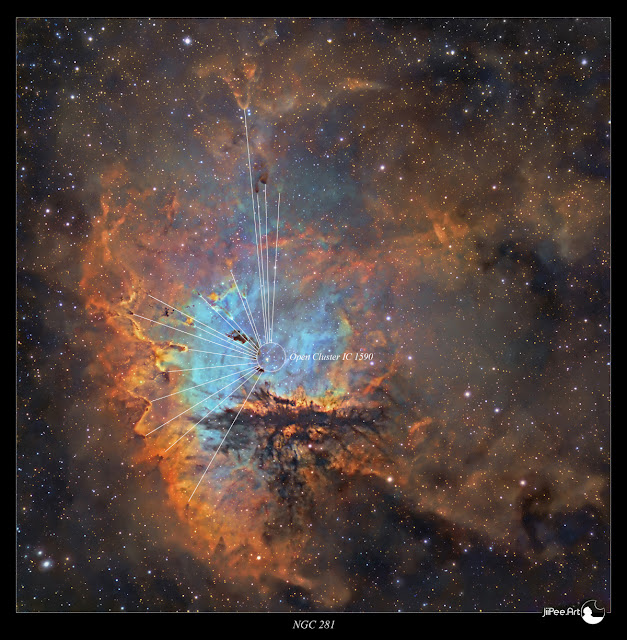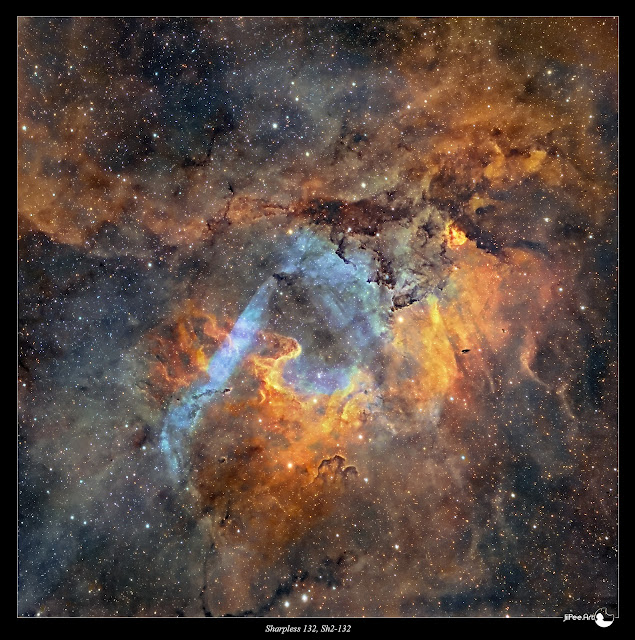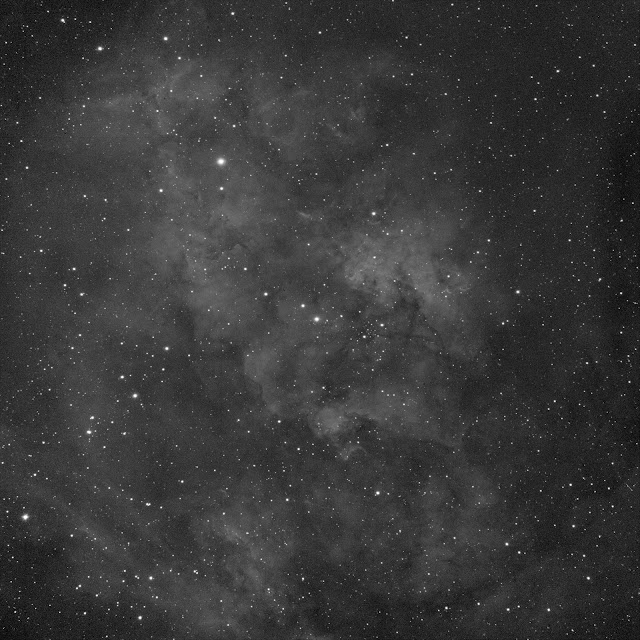COPYRIGHT, PLEASE NOTE
Wednesday, January 8, 2025
Sharpless 132 as four panel mosaic
I have originally published this four panel mosaic photo back in February 2019. I have added new data to it and generally reprocessed the whole thing, it's funny how much an old guy can learn in few years.
You can see the old version here: https://astroanarchy.blogspot.com/2019/02/sharpless-132-sh2-132.html
It's not bad by any means but new version reveals so much more. The central part of the mosaic is new data from autumn season 2024, it's better processed and has a better overall resolution due to new imaging setup.
Click for a full size, 2700x2400 pixels
sulfur=red, hydrogen=green and oxygen=blue
https://astroanarchy.blogspot.com/2024/12/sharpless-132-furious-cosmic-horse-gets.html
Saturday, January 4, 2025
New photo of NGC 281
Deep view to the NGC 281
Click for a full size, 2700x2500 pixels
The seeing wasn't very good so I couldn't quite split the two of the stars but it can be seen, that there are two stars very close to each other visually.
sulfur=red, hydrogen=red and oxygen=blue, this combination is very close to a natural color palette.
INFO
NGC 281 is a busy workshop of star formation. Prominent features include a small open cluster of stars, a diffuse red-glowing emission nebula, large lanes of obscuring gas and dust, and dense knots of dust and gas in which stars may still be forming. The open cluster of stars IC 1590 visible around the center has formed only in the last few million years. The brightest member of this cluster is actually a multiple-star system shining light that helps ionize the nebula's gas, causing the red glow visible throughout. The lanes of dust visible below the center are likely homes of future star formation. Particularly striking in the above photograph are the dark Bok globules visible against the bright nebula. Stars are surely forming there right now. The entire NGC 281 system lies about 10 thousand light years distant. (Source, NASA APOD)
With my new imaging system I can get deeper with a good resolution, than my old long focal length toolset was able to. The secondary mirror focusing system takes care of focusing and temperature compensation, I can keep the heavy main mirror locked down all the time. Heavy mirror has a tendency to move a bit when the scope moves and that can mess up the collimation.
The current system keeps collimation perfect all the time.
An other great accessory is the Active Optics Unit from Starlight Xpress. It's as easy to use as any OAG, the good update speed to a 11 mag star is around 8Hz. The AO-unit removes all the minor tracking errors very fast. The Mesu Mount Mark II has a periodic error under four arcseconds and that's a very small error, even so, AO unit gives a better image quality since the corrections are made by moving a light weight piece of glass, the heavy load of the scope and accessories doesn't need to move for corrections.
Structure study of the NGC 281
 Pillar like formations in the gas cloud are forming when the radiation pressure (Solar Wind) from the open cluster IC 1590 blows the gas and dust away and coursing some parts of the gas collapse.Due to that, they all are pointing to the source of the solar wind, open cluster IC 1590, as I have shown in the image above.
Pillar like formations in the gas cloud are forming when the radiation pressure (Solar Wind) from the open cluster IC 1590 blows the gas and dust away and coursing some parts of the gas collapse.Due to that, they all are pointing to the source of the solar wind, open cluster IC 1590, as I have shown in the image above.Please, click for a large image
O-III,9x 1200 s, binned 2x2 = 3h
A single calibrated 20 min exposure of H-alpha, Bin 1x1
Tuesday, December 31, 2024
My photo was selected as a cover picture of the Official Year Calendar of Vatican Observatory 2025
The Vatican observatory selected my photo of Sharpless 157 as a cover picture of an Official Calendar of the Vatican Observatory.
I have had my photos in this yearly published calendar about ten times and this is a second time my photo was selected as a cover, first time was back in 2019, the cover picture can be seen here: https://astroanarchy.blogspot.com/2018/12/astro-anarchy-gets-published-cover.html
Sharpless 157, the Cover Picture of the Vatican Observatory Calendar

Here is a link to blog post about this photo there are all the technical details and more info about this target: https://astroanarchy.blogspot.com/2018/02/sharpless-157-in-cassiopeia-project.html
You can buy the Vatican Observatory Calendar from here:
https://www.vaticanobservatory.org/product/2025-vatican-observatory-calendar/
All of my photos from the Year 2024
As usually, I'm publishing a poster format presentation of my photos at end of the year. This time all of the material is shot at Autumn Season 2024 since I got my new imaging platform up and running by then.
I haven't been able to produce any new material for almost three years due to some health problems. After hard times I'm back and well again.
Building a new imaging system fully functional took couple of years. It's working now very well, only some small tweaking has to be done next year, I'll do it during the mandatory Summer pause of six months.
All of my photos from the Year 2024
Click for a full size image
Photo Details
From top left to bottom right
- MWP1, https://astroanarchy.blogspot.com/2024/10/methuselah-nebula-mwp1-project-finalized.html
- WR 134, https://astroanarchy.blogspot.com/2024/10/wr-134-rising-phoenix.html
- NGC 7380, the Wizard Nebula, https://astroanarchy.blogspot.com/2024/12/wizard-nebula-ngc-7380.html
- Sharpless 132, https://astroanarchy.blogspot.com/2024/12/sharpless-132-furious-cosmic-horse-gets.html
- Pelican Nebula, https://astroanarchy.blogspot.com/2024/12/sharpless-132-furious-cosmic-horse-gets.html
- Sharpless 112, https://astroanarchy.blogspot.com/2024/12/pansy-of-swan-sharpless-112.html
- Tulip nebula, https://astroanarchy.blogspot.com/2024/11/balck-hole-cygnus-x-1-and-tulip-nebula.html
- Sharpless 115, https://astroanarchy.blogspot.com/2024/12/new-photo-sharpless-115-in-cygnus.html
The Cover picture of the Official Year Calendar of Vatican Observatory
My photo of Sharpless 157 was selected as a cover picture of the Vatican Observatory Calendar
My Work in the Media, some highlights
Vatican
My TV-interview in a live talk show,
"This Astrophotographer Captures the Universe Unlike Anyone Else"
JEREMY GRAY
You can read the article here:
"Olemme kaikki supernovien lapsia"
https://www.kaleva.fi/olemme-kaikki-supernovien-lapsia-oululainen-tahtik/11396012
Monday, December 23, 2024
Sharpless 132, A closeup
I published my latest photo out of Sh-2132 emission nebula just few days ago.
Now I'm publishing a "Spinoff" image out of it. Since the photo was a very high resolution one, I'm able to cut out a new composition out of it. The cut out has a resolution of 4000x4400 pixels.
Sharpless 132, Up Close and Personal
Click for a full size photo, 2000x2200 pixels
sulfur=red, hydrogen=green and oxygen=blue
https://astroanarchy.blogspot.com/2024/12/sharpless-132-furious-cosmic-horse-gets.html
Saturday, December 21, 2024
Sharpless 132, A Furious Cosmic Horse Gets Blinded by a Divine Blue Light
This is one of my favorite targets in Cepheus, Sh2-132 has an interesting structures due to massive energetic stars in it. I haven't found any explanation to the blue, jet like, structure glowing blue light of ionized Oxygen (O-III), the structure is visible also in H-alpha light.
When I shot firs photos out of this distant object about twenty years ago, I gave a longish name to it, "A Furious Cosmic Horse Gets Blinded by a Divine Blue Light" I don't usually name my photos but with some of them I simply must do so.
This is a kind of high resolution photo taken with my new imaging platform, it covers about 0.7 x0.7 degrees of sky. (Full Moon has an apparent diameter 0,5 degrees) Seeing was very good to my location, FWHM about 1.6 arcseconds, that's rare up here.
Sharpless 132
A Furious Cosmic Horse Gets Blinded by a Divine Blue Light
 A mapped color image from a light emitted by an ionized elements,
A mapped color image from a light emitted by an ionized elements, sulfur=red, hydrogen=green and oxygen=blue
sulfur=red, hydrogen=red and oxygen=blue, this combination is very close to a natural color palette.
A single calibrated 20 min exposure of H-alpha, Bin 1x1
Thursday, December 19, 2024
Pansy of the Swan, Sharpless 112
My previous image was showing the Sharpless 115 an emission nebula area in Cygnus, just next to it lays another Sharpless catalog target, Sh2-112.
My new photo about Sh2-112 has O-III and S-II data from my older image of Sharpless 112 from the October 2015. The new H-alpha data is much deeper and has a higher resolution. For some reason, this target has always been very difficult to process. Details in a background are very diffused and the actual emission nebula has a vast dynamic range, from a very bright to a very dim features.
I renamed this target to a "Pansy of the Swan" since the bright nebula looks like a blooming yellow pansy.
sulfur=red, hydrogen=green and oxygen=blue
sulfur=red, hydrogen=red and oxygen=blue, this combination is very close to a natural color palette.

This is my very large mosaic photo of the whole Cygnus, more info about this massive photo
Sunday, December 15, 2024
New Photo, Sharpless 115 in Cygnus
This Portion of sky covers less than a square degrees of sky in Constellation Cygnus, the Swan.
This star nursery has always looked to me like like it was cut out of the Baroque painting.
I was able to shoot a high resolution data for it with my new imaging setup. The Celestron Edge 14". This telescope has a beautiful optics and with a secondary mirror focuser, it'll hold the collimation perfectly all the time. Normally the heavy main mirror is used for focusing and it can be source of optical problems when it moves due to gravity when the scope is moving and pointing to a different portions of sky.
BAROQUE SKY OF SHARPLESS 115
Click for a full size photo, 2000x2000 pixels
sulfur=red, hydrogen=green and oxygen=blue
Shining with the light of ionized atoms of hydrogen, sulfur, and oxygen in this Hubble palette color composite image, the nebular glow is powered by hot stars in star cluster Berkeley 90. The cluster stars are likely only 100 million years old or so and are still embedded in Sharpless 115. But the stars' strong winds and radiation have cleared away much of their dusty, natal cloud. At the emission nebula's estimated distance, this cosmic close-up spans just under 100 light-years.
Source: NASA APOD
sulfur=red, hydrogen=red and oxygen=blue, this combination is very close to a natural color palette.
This is my very large mosaic photo of the whole Cygnus, more info about this massive photo

















.jpg)






















